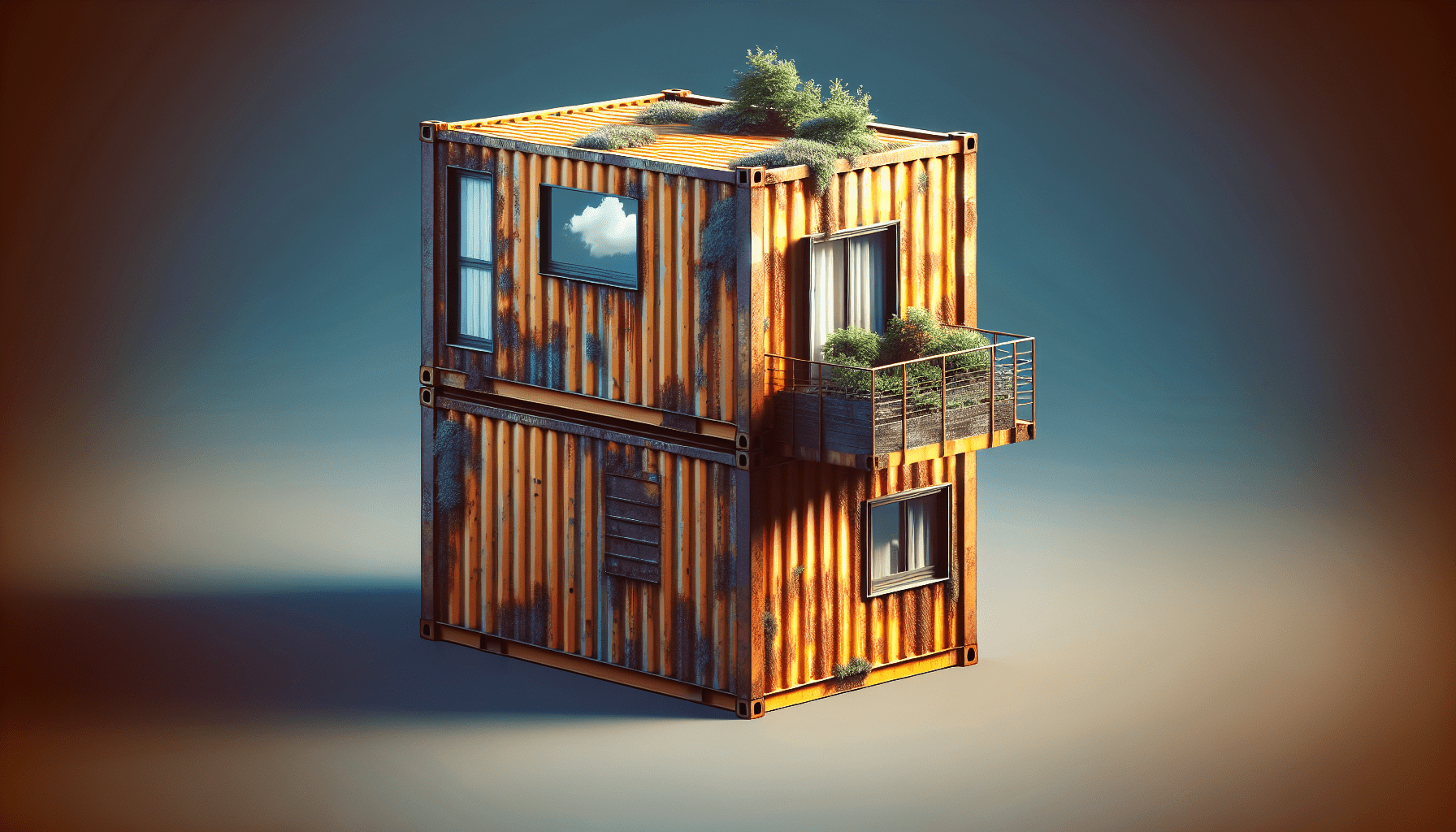So you’re considering building a home out of shipping containers? While the idea may seem enticing, it’s important to take a step back and consider the potential drawbacks of this alternative housing option. From limited space and restricted design possibilities to potential health concerns, there are a few crucial factors to keep in mind before diving headfirst into the world of shipping container homes. Don’t worry though, we’re here to give you a balanced perspective on the pros and cons of this unique living arrangement.
Structural Challenges
Limited design options
When it comes to designing a shipping container home, one of the main challenges you may face is the limited design options. Shipping containers come in standard sizes and shapes, which means your options for creating unique and custom layouts may be limited. While it is possible to connect multiple containers or modify their structure, it can be a complex and costly process.
Weakness in load-bearing points
Another structural challenge of shipping container homes is the weakness in load-bearing points. Shipping containers are primarily designed to bear weight on their four corners, making them less ideal for supporting loads at other points. If you plan to make significant modifications or add additional floors to your container home, you may need to reinforce the structure with extra support beams, which can add to the overall cost and complexity of the project.
Potential for rust and corrosion
Shipping containers are made from steel, which makes them highly susceptible to rust and corrosion. If the container is not properly maintained or protected, exposure to moisture and harsh weather conditions can lead to rust formation, weakening the structure over time. Regular inspection and maintenance are essential to prevent rust and ensure the longevity of your shipping container home.
Insulation Issues
Difficulty in maintaining optimal temperature
As you consider building a shipping container home, insulation should be a major concern. Shipping containers are not naturally equipped with insulation, making it challenging to maintain optimal temperature inside the home. Without proper insulation, the interior can become excessively hot in summer and cold in winter. It is crucial to invest in insulation materials and techniques to create a comfortable living environment.
Lack of proper insulation material
Finding suitable insulation materials for shipping container homes can be a struggle. Traditional insulation materials like fiberglass or cellulose may not fit well in the irregular spaces of containers. However, there are alternative insulation options available, such as spray foam insulation or insulated panels, which can effectively address the insulation needs of shipping container homes.
Condensation problems
Due to the temperature differences between the interior and exterior of a shipping container, condensation can become a significant issue. Condensation occurs when warm, moist air comes into contact with cold surfaces, leading to the formation of water droplets. This can result in dampness and potential damage to the interior of the container home. Adequate ventilation and moisture control measures are essential to prevent condensation-related problems.
Space Constraints
Limited interior space
Shipping containers, by their nature, have limited interior space compared to traditional homes. The standard sizes of shipping containers restrict the amount of living area you can have in your home. While it is possible to combine multiple containers or create multi-level structures, it can still be challenging to achieve the same spaciousness as a conventional house. Creative and efficient space planning becomes crucial to make the most of the available square footage.
Challenges in modifying container layout
Modifying the layout of a shipping container home can be tricky due to its rigid structure. The walls and floors of shipping containers are designed to bear weight, making it difficult to accommodate additional windows, doors, or structural changes. However, with careful planning and the help of experienced professionals, it is possible to make the necessary modifications and create a functional and aesthetically pleasing container home.
Difficulty in scaling up
If you envision expanding your home or adding extra rooms in the future, shipping containers may not be the most flexible option. Scaling up a shipping container home can be challenging, as it requires connecting additional containers, reinforcing the structure, and ensuring proper load distribution. The limitations of shipping containers in terms of size and shape can make it difficult to seamlessly expand your home as your needs evolve.

Permits and Regulations
Zoning restrictions
When planning to build a shipping container home, you must consider any zoning restrictions or regulations imposed by local authorities. Zoning laws vary from one area to another, and some places may have specific rules regarding the use of shipping containers as primary residences. Researching and complying with the applicable zoning regulations is crucial to avoid legal hurdles and ensure a smooth building process.
Building code compliance
In addition to zoning restrictions, shipping container homes must adhere to building codes and safety standards. These codes usually dictate requirements for structural integrity, electrical systems, plumbing, and fire safety, among others. Adapting a shipping container to a livable space that meets all the necessary codes can be a complex and time-consuming process, often requiring the involvement of engineers and architects.
Necessity for engineering approval
Due to the unique nature of shipping container homes, engineering approval may be necessary before you can proceed with construction. Engineers may need to assess the structural integrity and safety of the modified containers, especially if you plan to make significant modifications or stack containers on top of each other. This additional step in the building process can add to the overall time and cost involved.
Health and Safety Concerns
Presence of harmful chemicals in the container
Shipping containers may contain residual chemicals from their previous use, such as pesticides, paints, or other substances. These chemicals can pose health hazards if not properly addressed. It is essential to thoroughly clean and prepare the container, removing any potential toxins and ensuring a safe living environment for you and your family.
Potential for exposure to hazardous materials
In some cases, shipping containers may have been used for transporting hazardous materials, which can leave behind traces or contamination. If not properly identified and addressed, this exposure can pose significant health risks. Prior inspection and testing for hazardous materials are recommended to ensure the safety of the container home occupants.
Difficulty in ensuring proper ventilation
Ventilation is crucial for maintaining a healthy indoor environment, yet it can be challenging to achieve in a shipping container home. Limited window options and the airtight nature of containers can impede natural airflow and the exchange of fresh air. Proper ventilation systems, such as mechanical or passive ventilation, should be carefully planned and implemented to ensure good air quality and prevent moisture or odour-related issues.
Lack of Aesthetics
Industrial look and feel
Shipping container homes often have an industrial aesthetic that may not appeal to everyone. The corrugated steel walls and boxy shape can give the home a utilitarian appearance, which may not align with traditional or architectural styles preferred in certain neighborhoods. Achieving a visually pleasing exterior design may require additional modifications or disguising techniques to soften the industrial look.
Limited customization options
While customization is possible with shipping container homes, there are inherent limitations. The fixed dimensions and structural constraints of shipping containers can make it challenging to achieve certain design elements or architectural features. If you have specific customization requirements or a particular style in mind, additional construction work and creative problem-solving may be necessary to achieve your desired outcome.
Challenges in blending with traditional neighborhoods
Container homes may face resistance when it comes to blending into traditional neighborhoods. Some communities may have strict architectural guidelines and regulations that dictate the look and style of residential properties. Shipping container homes can stand out and be perceived as out of place within such neighborhoods, potentially causing tension or disapproval from neighbors. It is essential to consider the overall aesthetic harmony of the surrounding environment when planning a container home.
Transportation and Installation
High transportation costs
Moving shipping containers to the construction site can be an expensive endeavor. The cost of transporting containers depends on various factors, including the distance, accessibility of the site, and any logistical challenges along the way. Additionally, specialized equipment such as cranes or forklifts may be required to unload and position the containers, adding to the overall cost of transportation.
Specialized equipment requirements
Installing shipping containers requires specialized equipment due to their size and weight. Heavy machinery, such as cranes or a tilt-bed truck, may be necessary for proper placement and alignment. Renting or hiring equipment, along with the operators, can incur additional expenses that need to be factored into the overall budget and planning of your container home project.
Complications during delivery and installation
Despite careful planning, complications can arise during the delivery and installation of shipping containers. Factors such as difficult terrain, narrow access points, or unpredictable weather conditions can pose challenges and delays. It is crucial to work with experienced professionals who can navigate these potential complications and ensure a smooth and successful installation process.
Limited Availability
Scarcity of suitable land for container homes
Finding suitable land for a container home can be a challenge in itself. Zoning restrictions, land availability, and the specific requirements for container homes may limit your options. Additionally, desirable locations or neighborhoods may not permit container homes, further restricting the available land choices. Thorough research and working closely with real estate professionals can help identify suitable land options for your shipping container home.
Limited access to used shipping containers
Although shipping containers may seem abundant, finding quality used containers in good condition can be challenging. Containers that have been used extensively for shipping may have undergone wear and tear or have structural issues. It is essential to carefully inspect and select containers that meet your specific requirements to ensure a solid foundation for your container home.
Increasing demand leading to higher prices
As the popularity of shipping container homes grows, so does the demand for containers. This increasing demand can lead to higher prices for both new and used containers. The cost of containers, along with associated materials and construction expenses, can significantly impact the overall budget of your project. Planning and budgeting accordingly to account for potential price fluctuations is crucial to avoid surprises or financial strain.
Maintenance and Repairs
Regular maintenance required to prevent decay
To ensure the longevity of a shipping container home, regular maintenance is essential. The steel structure of containers is susceptible to rust and corrosion, especially in areas with high humidity or coastal environments. Regular inspections, cleaning, and protective coatings are necessary to prevent decay and maintain the structural integrity of the container home.
Challenges in fixing structural damages
In the event of structural damages, repairing shipping containers can be challenging. The steel walls and structure of shipping containers require specialized knowledge and tools to restore. Moreover, finding replacement parts that fit the specific dimensions of shipping containers can be difficult. Engaging experts in container modification and repair work is crucial to address any structural damages effectively.
Expense of repairing and replacing parts
Repairing or replacing damaged parts of a shipping container home can be costly. The specialized nature of container repairs and the need for custom-made components can drive up the expenses. It is important to consider these potential costs when budgeting for your container home and maintain a contingency fund to address any unexpected repair needs.
Social Stigma
Negative perception of container homes
Despite the increasing popularity of container homes, there is still a negative perception attached to them. Some people may view container homes as inferior or less desirable compared to traditional stick-built houses. Overcoming this prejudice and educating others about the benefits and potential of shipping container homes may be necessary, especially if you plan to sell or rent your property in the future.
Potential difficulty in selling or renting
Due to the social stigma associated with container homes, selling or renting a container home may pose challenges. Potential buyers or tenants may have reservations about living in a non-traditional home, which can limit your pool of interested parties. Effective marketing and highlighting the unique features and advantages of container homes can help attract the right audience and overcome any potential difficulties in selling or renting.
Resistance from neighbors and communities
Container homes may face resistance from neighbors and communities, particularly in areas with strict architectural regulations. Concerns over the appearance, perceived impact on property values, or the perceived non-conformity of container homes may lead to opposition from neighbors. Open communication, addressing concerns, and actively engaging with the community can help alleviate resistance and foster acceptance of container homes.
In conclusion, while shipping container homes offer unique advantages such as affordability, sustainability, and flexibility, they also come with their fair share of challenges. From structural limitations and insulation issues to zoning regulations and social stigma, it is important to consider and address these drawbacks before embarking on a shipping container home project. With proper planning, professional guidance, and a clear understanding of the potential challenges, you can overcome these obstacles and create a comfortable and functional container home that suits your needs and lifestyle.

I am James, the creator behind SeaBoxInnovations.com. Welcome to our premier online destination dedicated to the world of sea containers. Think Inside the Box is our tagline, and our website is your go-to source for exploring the endless potential of these versatile and adaptable containers. Whether you’re interested in purchasing, customizing, or learning about the latest trends in container architecture and design, we have you covered. Join us as we bridge the gap between traditional uses and cutting-edge applications, promoting sustainability and innovation in design and construction. Get ready to embark on your next big project with SeaBoxInnovations.com.

